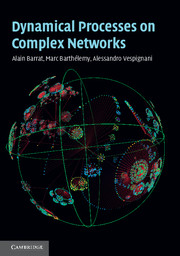Book contents
- Frontmatter
- Contents
- Preface
- Acknowledgements
- List of abbreviations
- 1 Preliminaries: networks and graphs
- 2 Networks and complexity
- 3 Network models
- 4 Introduction to dynamical processes: theory and simulation
- 5 Phase transitions on complex networks
- 6 Resilience and robustness of networks
- 7 Synchronization phenomena in networks
- 8 Walking and searching on networks
- 9 Epidemic spreading in population networks
- 10 Social networks and collective behavior
- 11 Traffic on complex networks
- 12 Networks in biology: from the cell to ecosystems
- 13 Postface: critically examining complex networks science
- Appendix 1 Random graphs
- Appendix 2 Generating functions formalism
- Appendix 3 Percolation in directed networks
- Appendix 4 Laplacian matrix of a graph
- Appendix 5 Return probability and spectral density
- References
- Index
3 - Network models
Published online by Cambridge University Press: 05 September 2012
- Frontmatter
- Contents
- Preface
- Acknowledgements
- List of abbreviations
- 1 Preliminaries: networks and graphs
- 2 Networks and complexity
- 3 Network models
- 4 Introduction to dynamical processes: theory and simulation
- 5 Phase transitions on complex networks
- 6 Resilience and robustness of networks
- 7 Synchronization phenomena in networks
- 8 Walking and searching on networks
- 9 Epidemic spreading in population networks
- 10 Social networks and collective behavior
- 11 Traffic on complex networks
- 12 Networks in biology: from the cell to ecosystems
- 13 Postface: critically examining complex networks science
- Appendix 1 Random graphs
- Appendix 2 Generating functions formalism
- Appendix 3 Percolation in directed networks
- Appendix 4 Laplacian matrix of a graph
- Appendix 5 Return probability and spectral density
- References
- Index
Summary
In this chapter we present a review of network models that will be used to study dynamical processes in the context of computational approaches. These different models will also help to determine the influence that specific network features have on the various phenomena that will be considered in the next chapters. To this end, we will discuss the different modeling approaches and put the activity focused on each of the different dynamical models into the proper perspective. Particular emphasis will be devoted to models which have been developed as theoretical examples of the different specific classes of real-world networks empirically observed.
Randomness and network models
Static random graph models and topology generators such as the paradigmatic Erdős–Rényi model (Erdős and Rényi, 1959; 1960; 1961) and the network generation algorithm of Molloy and Reed (1995) are the simplest network models to include stochasticity as an essential element. They are characterized by an absolute lack of knowledge of the principles that guide the creation of edges between nodes. Lacking any information, the simplest assumption one can make is to connect pairs of nodes at random with a given connection probability p. In its original formulation, an Erdős–Rényi graph GN, E is constructed starting from a set of N different vertices which are joined by E edges whose ends are selected at random among the N vertices.
- Type
- Chapter
- Information
- Dynamical Processes on Complex Networks , pp. 50 - 76Publisher: Cambridge University PressPrint publication year: 2008



